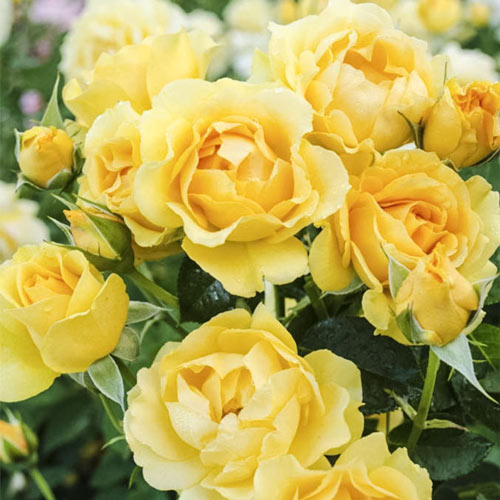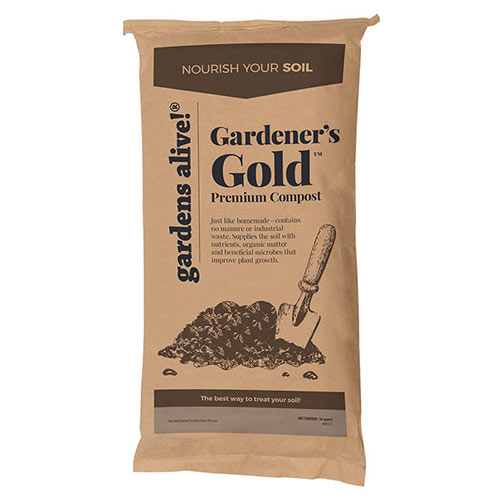The Important Secrets of Springtime Mulch
-
Helpful Products from Gardens Alive!
-
 Bulbs Alive!™ Fertilizer
Bulbs Alive!™ Fertilizer -
 Julia Child Floribunda Rose Plant
Julia Child Floribunda Rose Plant -
 Gardener's Gold™ Premium Compost
Gardener's Gold™ Premium Compost
Q. Betty in Media PA writes: "With the weather getting so much warmer (and wetter), I was wondering when I should pull back the leaf mulch over top of my peonies. This is their first spring in this location. They were my grandmothers, then my mothers, and then they lived at my first home for 20 years. I fostered divisions from some of them at friends' houses so I would have them for my new home, so they will just be babies again. Any ideas?"
A. Peonies are herbaceous perennials, meaning that they die back to the ground every fall, as opposed to woody perennials like roses. Your peony roots (or rhizomes or whatever) are, as they should be right now, sound asleep thanks to that shredded leaf mulch. The purpose of mulch over winter is to maintain a fairly stable soil temperature, thus preventing the heaving and thawing that can otherwise occur in winters with wild swings between freezing cold and sixty-degree days, like this winter in Pennsylvania and much of the rest of the East Coast.
Now, peonies are spring bloomers, but they're not the earliest ones, and your baby plants should be pampered right now, so leave their mulch in place. Move the mulch around gently every couple of weeks until you see those distinctive bright red shoots breaking ground and then gently remove the mulch so the soil can warm up and the shoots don't have to work hard while they emerge. Toss the shredded leaves into your compost or save them for mulching your summer garden.
Spring bulbs are another story, however. They should also be mulched over winter to prevent their heaving out of the ground, but the mulch must be removed before the tiny ones like snowdrops and Glory of Snow begin to flower, which can be very early in the season. But removing frozen mulch can be a disaster, shredding the dainty little flowers. That's why we freed up those beds in our own garden during a warm spell back in January, when the shredded leaves were no longer frozen. As a result, we have been rewarded by a nice show of these special little bulbs. The earlier and more fragile the flower, the sooner you should un-mulch them.
Depending on where you live, it might be time to start removing the mulch on other spring bulbs; earlier down south and later in the north and Midwest. But you have more wiggle room here, as daffodils and tulips are bigger and stronger and its harder to hurt them. Crocus are kind of in-between; they're not as fragile as the first bulbs to emerge, but their flowers can still be damaged by rough raking, especially if the mulch is still partially frozen; so go slow and gentle. Take your time and they'll be fine. Same with other 'minor' bulbs like grape hyacinth and Siberian squill; uncover early and be gentle about it.
Under no circumstances should you remove frozen mulch from small-flowered bulbs with anything but your hands. And even then, try and do it during a warm spell.
And even though my alleged topic is mulch, I must digress into some advice on insuring spring bulb return. The biggest reason for bulbs being one-season wonders is their caretakers cutting down their leaves while they're still green. You must allow the greenery to collect solar energy for the plant to grow another flower deep inside the bulb. (Right after the flowers fade is also the time to feed spring bulbs; not when you plant them in the Fall.) You can remove the leaves when they lose their deep green color.
Back to Betty in Media. Are there other peonies in your neighborhood? If so, keep an eye out for their emerging sprouts and make sure yours are uncovered while those neighboring sprouts are still small. Be gentle; although mature peony shoots are pretty tough, you don't want to stress what might be the thinner shoots of a baby plant. (Same rule with the greenery; don't cut it off prematurely.)
If your other garden beds are mulched to prevent weeds and freezing and thawing, remove the mulch two weeks before you intend to plant anything in those beds. Mulch keeps the soil underneath at a constant temperature, but it prevents the sun from warming up those beds. If your beds are mulched with compost, shredded leaves, pine straw, pine fines, or straw, move the material to the side and let the bed warm up. If you install live plants that are already a good size, put the mulch back into place right away. If you're planting seeds of lettuce, kale, spinach, string beans, etc., wait until the plants are up and growing for two solid weeks before putting the mulch back into place.
If you used any kind of wood mulch, hoe it off your beds and other plants, make a big pile of it, stick a pole in the middle, set the pile on fire on May 1st (or the first Monday in May if you're Irish) and invite Morris Dancers to parade around the bonfire with bells and flowing scarves to bless your garden for the coming season. And to beg penance for you for using junk wood trash in your landscape.
A. Peonies are herbaceous perennials, meaning that they die back to the ground every fall, as opposed to woody perennials like roses. Your peony roots (or rhizomes or whatever) are, as they should be right now, sound asleep thanks to that shredded leaf mulch. The purpose of mulch over winter is to maintain a fairly stable soil temperature, thus preventing the heaving and thawing that can otherwise occur in winters with wild swings between freezing cold and sixty-degree days, like this winter in Pennsylvania and much of the rest of the East Coast.
Now, peonies are spring bloomers, but they're not the earliest ones, and your baby plants should be pampered right now, so leave their mulch in place. Move the mulch around gently every couple of weeks until you see those distinctive bright red shoots breaking ground and then gently remove the mulch so the soil can warm up and the shoots don't have to work hard while they emerge. Toss the shredded leaves into your compost or save them for mulching your summer garden.
Spring bulbs are another story, however. They should also be mulched over winter to prevent their heaving out of the ground, but the mulch must be removed before the tiny ones like snowdrops and Glory of Snow begin to flower, which can be very early in the season. But removing frozen mulch can be a disaster, shredding the dainty little flowers. That's why we freed up those beds in our own garden during a warm spell back in January, when the shredded leaves were no longer frozen. As a result, we have been rewarded by a nice show of these special little bulbs. The earlier and more fragile the flower, the sooner you should un-mulch them.
Depending on where you live, it might be time to start removing the mulch on other spring bulbs; earlier down south and later in the north and Midwest. But you have more wiggle room here, as daffodils and tulips are bigger and stronger and its harder to hurt them. Crocus are kind of in-between; they're not as fragile as the first bulbs to emerge, but their flowers can still be damaged by rough raking, especially if the mulch is still partially frozen; so go slow and gentle. Take your time and they'll be fine. Same with other 'minor' bulbs like grape hyacinth and Siberian squill; uncover early and be gentle about it.
Under no circumstances should you remove frozen mulch from small-flowered bulbs with anything but your hands. And even then, try and do it during a warm spell.
And even though my alleged topic is mulch, I must digress into some advice on insuring spring bulb return. The biggest reason for bulbs being one-season wonders is their caretakers cutting down their leaves while they're still green. You must allow the greenery to collect solar energy for the plant to grow another flower deep inside the bulb. (Right after the flowers fade is also the time to feed spring bulbs; not when you plant them in the Fall.) You can remove the leaves when they lose their deep green color.
Back to Betty in Media. Are there other peonies in your neighborhood? If so, keep an eye out for their emerging sprouts and make sure yours are uncovered while those neighboring sprouts are still small. Be gentle; although mature peony shoots are pretty tough, you don't want to stress what might be the thinner shoots of a baby plant. (Same rule with the greenery; don't cut it off prematurely.)
If your other garden beds are mulched to prevent weeds and freezing and thawing, remove the mulch two weeks before you intend to plant anything in those beds. Mulch keeps the soil underneath at a constant temperature, but it prevents the sun from warming up those beds. If your beds are mulched with compost, shredded leaves, pine straw, pine fines, or straw, move the material to the side and let the bed warm up. If you install live plants that are already a good size, put the mulch back into place right away. If you're planting seeds of lettuce, kale, spinach, string beans, etc., wait until the plants are up and growing for two solid weeks before putting the mulch back into place.
If you used any kind of wood mulch, hoe it off your beds and other plants, make a big pile of it, stick a pole in the middle, set the pile on fire on May 1st (or the first Monday in May if you're Irish) and invite Morris Dancers to parade around the bonfire with bells and flowing scarves to bless your garden for the coming season. And to beg penance for you for using junk wood trash in your landscape.
-
Helpful Products from Gardens Alive!
-
 Bulbs Alive!™ Fertilizer
Bulbs Alive!™ Fertilizer -
 Julia Child Floribunda Rose Plant
Julia Child Floribunda Rose Plant -
 Gardener's Gold™ Premium Compost
Gardener's Gold™ Premium Compost







 Gardens Alive! & Supplies
Gardens Alive! & Supplies




